Distribution
|
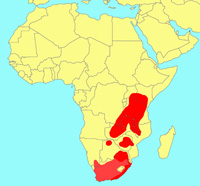
Uganda, Kenya, Tanzania, south eastern
Democratic Republic of Congo, Zambia, Malawi, Mozambique, Zimbabwe,
Botswana, South Africa and Swaziland.
Planted widely in many areas of South Africa
outside the species' natural distribution in the eastern and northern
areas of the country. Commonly used as a shade tree on farms and at
roadside layovers or picnic stops. The pollinator
Elisabethiella stuckenbergi
and some of the non-pollinating wasp species have colonized these
planted populations, promoting the further natural spread of Ficus
burkei in the more arid western regions and winter rainfall areas of
the country.
|
Biology
|

Pollinator:
Elisabethiella stuckenbergi
(Grandi), but
Alfonsiella brongersmai
Wiebes and
Alfonsiella longiscapa
Joseph have also been recorded.
|
Habitat
|
Savanna woodland and wet or dry forest, up to an altitude of 1800m. |
Etymology
|
Named after
Joseph Burke (1812-1873) a British naturalist who collected the type
specimen of Ficus burkei from the Magaliesberg (South Africa) in
1841 while on an expedition with Carl Zeyher (Burrows & Burrows, 2003). |
Common names
|
Common wild
fig; Burke's fig; gewone wildevye (Afrikaans); umthombe (Zulu, Xhosa);
muumo (Venda); muome (Tswana) (Burrows & Burrows, 2003). |
Taxonomic history
|
This species
was previously synonymised with
Ficus thonningii by
Berg, 1990, but was re-instated as a valid species along with
Ficus
petersii by Burrows & Burrows, 2003. |
Frugivores
|
Birds, bats, monkeys, baboons, bushpig, warthog and
antelope such as bushbuck, nyala, duiker and klipspringer feed on the ripe figs
facilitating seed dispersal. |
|

African Green Pigeon
feeding on ripe
Ficus burkei figs (photograph
©
Tony Faria)

Purple-crested
Turaco
feeding on
Ficus burkei near Hluhluwe in
Kwazulu-Natal, South Africa (November 2019). Photograph
© Otto Schmidt (Cape Town).

Purple-crested
Turaco
feeding on
Ficus burkei near Hluhluwe in
Kwazulu-Natal, South Africa (November 2019). Photograph
© Otto Schmidt (Cape Town).
|
Insects
|
The larval
stages of a variety of insects feed on the leaves or figs of Ficus burkei including caterpillars of butterflies
and moths, some of which have developed remarkable strategies to
overcome the sticky latex contained in the leaves: |
|
 |
Asota speciosa
(latex
sabotage by the Speciose Tiger moth caterpillar) |
|
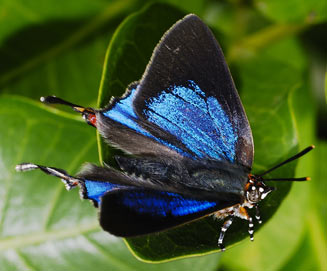 |
Myrina dermaptera
(Lesser fig-tree blue, Scarce fig-tree blue) |
|
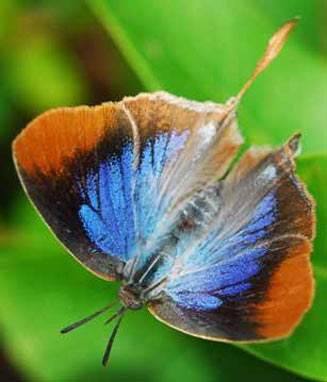 |
Myrina
silenus (Common
fig-tree blue) |
|
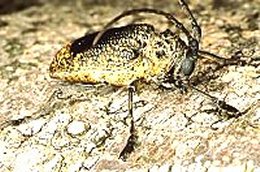
|
Beetle larvae of the
Fig tree borer beetle Phyrneta
spinator (Coleoptera) bore into the branches and trunks often
targeting water stressed, damaged or older trees.
|
References
|
Berg,
C.C. 1988. New taxa and combinations in Ficus (Moraceae) in
Africa. Kew Bulletin 43: 77- 97.
Berg,
C.C. 1989. Moraceae. In: R.M. Polhill (ed.) Flora of Tropical East Africa.
A.A. Balkema, Rotterdam.
Berg,
C.C. 1990. Distribution of African taxa of Ficus (Moraccae).
[Proc. 12th AETFAT]. Mitt. inst. Allg. Bot. Hamburg 23: 401-405.
Berg, C.C. 1990. Annotated check-list of the Ficus species
of the African floristic region, with special reference and a key to the
taxa of southern Africa. Kirkia, 13: 253-291.
Berg,
C.C. 1991. Moraceae. In: E. Launert & G.Y. Pope (eds) Flora
Zambesiaca 9, 6. Natural History Museum, London.
Berg, C.C. & Hijman, M.E.E. 1989. Chapter 11. Ficus. Flora of
Tropical East Africa (ed. R.M. Polhill). 43-86. A.A. Balkema,
Rotterdam.
Berg,
C.C., Hijman, M.E.E. & Weerdenburg, J.C.A. 1984. Moracées (incl.
Cécropiacées). Flore du Gabon 26: 1–276.
Berg,
C.C., Hijman, M.E.E. & Weerdenburg, J.C.A. 1985. Moracées (incl.
Cécropiacées). Flore du Cameroun 28: 1–298.
Berg, C.C. & Wiebes, J.T. 1992. African fig trees and
fig wasps. Koninklijke Nederlandse Akademie van Wetenschappen.
Amsterdam, 1-298 pp.
Bouček Z., A. Watsham & J.T. Wiebes, 1981. The fig wasp
fauna of the receptacles of Ficus thonningii (Hymenoptera,
Chalcidoidea). Tijdschrift Voor Entomologie, 124(5): 149-233.
Burrows, J. & Burrows,
S. 2003. Figs of southern & south-central Africa. Umdaus Press,
Hatfield. 379 pp.
|
Credits
|
Photographs (except as otherwise credited) and distribution map ©
Jean-Yves Rasplus (INRA) or ©
Simon van Noort (Iziko Museums of South Africa) or ©
Hamish Robertson (Iziko Museums of South Africa), or
© Otto Schmidt (Cape Town). Butterfly images ©
Steve Woodhall.
|
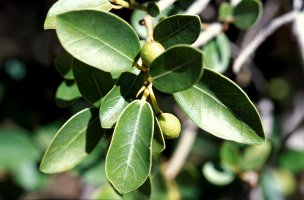 |
Ficus burtt-davyi Hutch. |
|